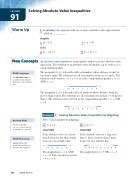Page 617 - Algebra 1
P. 617
L E S S O N Solving Absolute-Value Inequalities 91
Warm Up
New Concepts
1. Vocabulary An equation with one or more absolute-value expressions is
(74)
Simplify. 2. 8 - 15
(5)
Solve.
4. x - 4 = 7
(74)
called an .
3. -3 + 9 (5)
5. x + 7 = 2 (74)
An absolute-value inequality is an inequality with at least one absolute-value expression. The solution to an absolute-value inequality can be written as a compound inequality.
The inequality x < 6 describes all real numbers whose distance from 0 is less than 6 units. The solutions are all real numbers between -6 and 6. The solution can be written -6 < x < 6 or as the compound inequality x > -6 AND x < 6.
-6 -4 -2 0 2 4 6
The inequality x > 6 describes all real numbers whose distance from 0 is greater than 6 units. The solutions are all real numbers less than -6 or greater than 6. The solution can be written as the compound inequality x < -6 OR x > 6.
-6 -4 -2 0 2 4 6
Solving Absolute-Value Inequalities by Graphing
Math Language
The absolute value of
a number is its distance from zero on the number line.
Example
1
Solve each inequality by graphing.
a. x <4 SOLUTION
If the absolute value of x is less than 4, then x is less than 4 units from zero on a number line.
-4 -2 0 2 4
The graph shows x < 4 AND
x > -4. This can also be written -4 < x < 4.
b. x >7
SOLUTION
If the absolute value of x is greater than 7, then x is more than 7 units from zero on a number line.
-8 -6 -4 -2 0 2 4 6 8 The graph shows x > 7 OR x < -7.
Reading Math
For the inequality
-4 < x < 4, you can say, “x is between -4 and 4.”
Math Reasoning
Analyze Why is the word “OR” used here to describe the solution?
602 Saxon Algebra 1


